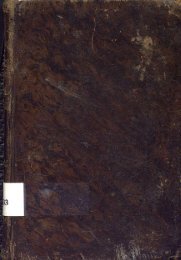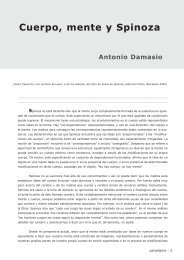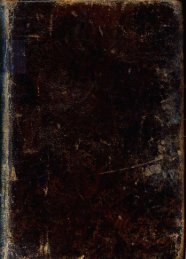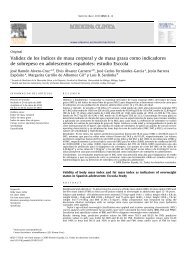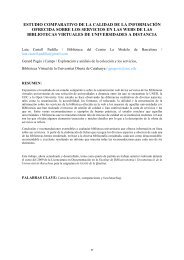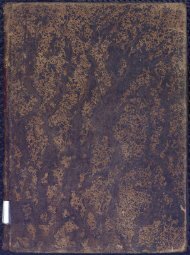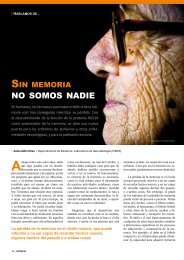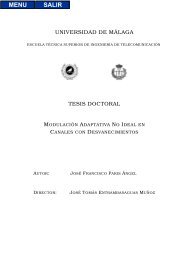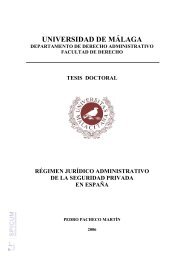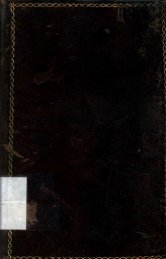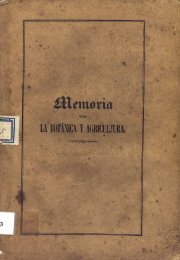Papel de las actividades superóxido dismutasa y catalasa en la ...
Papel de las actividades superóxido dismutasa y catalasa en la ...
Papel de las actividades superóxido dismutasa y catalasa en la ...
Create successful ePaper yourself
Turn your PDF publications into a flip-book with our unique Google optimized e-Paper software.
Journal of Fish Diseases 2006, 29, 355–364<br />
PDíaz-Rosales et al. Superoxi<strong>de</strong> dismutase and cata<strong><strong>la</strong>s</strong>e in P. damse<strong>la</strong>e ssp. piscicida<br />
intervals by a spectrophotometer (Hitachi U-2000:<br />
Hitachi, Tokyo, Japan). The amount of <strong>en</strong>zyme<br />
resulting in 50% of maximum inhibition of NBT<br />
reduction was <strong>de</strong>termined.<br />
Detection, characterization and quantification<br />
of cata<strong><strong>la</strong>s</strong>e activity<br />
Cata<strong><strong>la</strong>s</strong>e activity was visualized on non-<strong>de</strong>naturing<br />
acry<strong>la</strong>mi<strong>de</strong> gels following the methodology of<br />
Woodbury, Sp<strong>en</strong>cer & Stahmann (1971). After<br />
electrophoresis, gels were washed three times in<br />
distilled water for 20 min and soaked in a solution<br />
of 0.015% H 2 O 2 (30%) (Merck, Darmstadt,<br />
Germany). Th<strong>en</strong>, the activity was visualized by<br />
transferring the gels to a solution of 1% (w/v)<br />
ferric chlori<strong>de</strong> (Panreac Quimica, Barcelona,<br />
Spain) and 1% (w/v) potassium ferricyani<strong>de</strong><br />
(Sigma). Regions corresponding to cata<strong><strong>la</strong>s</strong>e activity<br />
were i<strong>de</strong>ntified as clear yellow bands on a dark<br />
gre<strong>en</strong> background.<br />
The metal cofactor of the cata<strong><strong>la</strong>s</strong>e produced by<br />
P. damse<strong>la</strong>e ssp. piscicida was <strong>de</strong>termined by<br />
<strong>en</strong>zymatic inhibition studies according to Barnes,<br />
Bow<strong>de</strong>n, Horne & Ellis (1999b). Lysates of<br />
P. damse<strong>la</strong>e ssp. piscicida strains were incubated<br />
for 1 h with either 100 and 50 mm potassium<br />
cyani<strong>de</strong> (KCN; Sigma), 1 and 0.5 mm mercuric<br />
chlori<strong>de</strong> (HgCl 2 ; Sigma), 25 and 12.5 mm sodium<br />
azi<strong>de</strong> (NaN 3 ; Sigma) or 50 mm phosphate buffer as<br />
control. Equal volumes of treated extracts were<br />
electrophoresed and gels stained for cata<strong><strong>la</strong>s</strong>e activity<br />
(Woodbury et al. 1971). Cata<strong><strong>la</strong>s</strong>es with manganese<br />
as metal cofactor are resistant against sodium azi<strong>de</strong><br />
and potassium cyani<strong>de</strong> and s<strong>en</strong>sitive to mercuric<br />
chlori<strong>de</strong> (Kono & Fridovich 1983; Allgood &<br />
Perry 1986; Barnes et al. 1999b). Control wells<br />
inocu<strong>la</strong>ted with extracts of Escherichia coli (ATCC<br />
13706) containing a ferric cata<strong><strong>la</strong>s</strong>e retained the<br />
activity after treatm<strong>en</strong>t with mercuric chlori<strong>de</strong> but<br />
not with sodium azi<strong>de</strong>.<br />
Cata<strong><strong>la</strong>s</strong>e activity was measured spectrophotometrically<br />
by monitoring the <strong>de</strong>crease in absorbance at<br />
240 nm due to <strong>de</strong>composition of hydrog<strong>en</strong> peroxi<strong>de</strong>.<br />
One unit of cata<strong><strong>la</strong>s</strong>e was <strong>de</strong>fined as the activity<br />
causing the hydrolysis of 1 lmol of hydrog<strong>en</strong><br />
peroxi<strong>de</strong> per minute (Aebi 1984). Briefly, bacterial<br />
extracts were diluted (1:100) in 50 mm potassium<br />
phosphate buffer, pH 7.0 and the absorbance of<br />
the sample containing 660 lL of lysate and<br />
340 lL of H 2 O 2 was measured against a b<strong>la</strong>nk<br />
with buffer. The <strong>de</strong>crease in absorbance at 240 nm<br />
(Hitachi U-2000) was monitored during a 10-min<br />
period.<br />
Bactericidal activity of sole phagocytes<br />
Mono<strong>la</strong>yers of sole phagocytes were prepared<br />
following the methodology of Secombes (1990).<br />
Briefly, the kidneys of 100–300 g sole were dissected<br />
and pressed through a 100 lm nylon mesh with<br />
L-15 medium (Gibco, Gaithersburg, MD, USA)<br />
containing 2% fetal calf serum (FCS; Sigma), 1%<br />
p<strong>en</strong>icillin/streptomycin (Sigma), 0.1% g<strong>en</strong>tamicin<br />
sulphate (50 mg mL )1 distilled water; Sigma) and<br />
10 U mL )1 sodium heparin. The resultant susp<strong>en</strong>sion<br />
was <strong>la</strong>yered onto a 30–51% (v/v) Percoll<br />
(Amersham Pharmacia, Piscataway, NJ, USA) <strong>de</strong>nsity<br />
gradi<strong>en</strong>t and the band of cells lying at the 30–<br />
51% interface was collected. The cell susp<strong>en</strong>sion<br />
was washed and adjusted to 10 7 cells mL )1 in L-15<br />
medium with antibiotics. The viability was <strong>de</strong>termined<br />
by the exclusion test with trypan blue<br />
(Sigma) (0.5% in PBS). A volume of 100 lL per<br />
well was ad<strong>de</strong>d to 96-well microtitre p<strong>la</strong>tes.<br />
Mono<strong>la</strong>yers were maintained at 22 °C overnight<br />
until bactericidal assays were performed.<br />
Bacterial culture conditions to <strong>de</strong>termine the<br />
ability to resist the bactericidal activity of phagocytes<br />
inclu<strong>de</strong>d growth until stationary phase, addition<br />
of two hydrog<strong>en</strong> peroxi<strong>de</strong> pulses and growth in<br />
replete or reduced iron medium as previously<br />
<strong>de</strong>scribed. The bacterial conc<strong>en</strong>tration was adjusted<br />
to 1 OD 600 , corresponding to 10 8 bacteria per mL.<br />
The methodology employed to test bacterial survival<br />
after contact with phagocytes was according to<br />
Secombes (1990).<br />
Phagocyte mono<strong>la</strong>yers were washed twice with<br />
L-15 and the cells were th<strong>en</strong> supplem<strong>en</strong>ted with<br />
100 lL L-15, 5% FCS per well. Bacterial susp<strong>en</strong>sions<br />
(20 lL) were ad<strong>de</strong>d to triplicate wells containing<br />
macrophages. The microtitre p<strong>la</strong>te was shak<strong>en</strong><br />
and c<strong>en</strong>trifuged at 150 g for 5 min to bring the<br />
bacteria into contact with cells and subsequ<strong>en</strong>tly<br />
incubated at 22 °C for 0 and 5 h. At the <strong>en</strong>d of the<br />
incubation period, the supernatants were removed<br />
and the killing stopped by lysing the phagocytes with<br />
50 lL of cold sterile distilled water. Subsequ<strong>en</strong>tly,<br />
100 lL of TSBs was ad<strong>de</strong>d to support the growth of<br />
the surviving bacteria for 18–20 h at 22 °C.<br />
The number of surviving bacteria was quantified<br />
colorimetrically following the methodology of Peck<br />
(1985) as modified by Graham, Jeffries &<br />
Secombes (1988). Briefly, 10 lL of 3 [4,5-di-<br />
Ó 2006<br />
B<strong>la</strong>ckwell Publishing Ltd<br />
358



